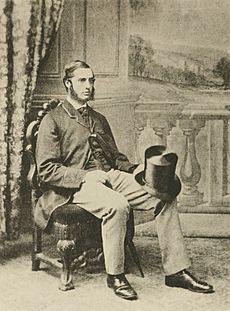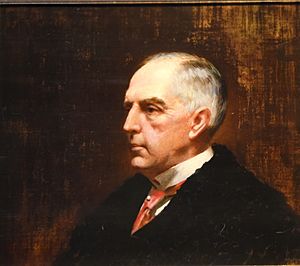Frederick DuCane Godman facts for kids
Quick facts for kids
Frederick DuCane Godman
|
|
|---|---|
 |
|
| Born | 15 January 1834 |
| Died | 19 February 1919 (aged 85) London, England
|
| Resting place | Cowfold, Sussex, England |
| Alma mater | Eton College (did not graduate) Trinity College, Cambridge |
| Known for | Founding the British Ornithological Union |
| Spouse(s) |
Edith Elwes
(m. 1873; died 1875)Alice Mary Chaplin
(m. 1891) |
| Children | 2 |
| Awards | Linnean Medal (1918) |
| Scientific career | |
| Fields | Lepidopterology, entomology, ornithology |
| Author abbrev. (botany) | Godm. |
Frederick DuCane Godman (born January 15, 1834 – died February 19, 1919) was an English scientist. He studied lepidopterology (butterflies and moths), entomology (insects), and ornithology (birds).
He was one of the twenty people who started the British Ornithologists' Union. This is a group for people who study birds. Frederick Godman and his friend Osbert Salvin are famous for their studies of animals and plants in Central America.
Godman also collected beautiful old pottery. His collection of over 600 pieces was later given to the British Museum.
Contents
Early Life and University Years
Frederick DuCane Godman was born in Godalming, Surrey, England. He was one of thirteen children. His father, Joseph Godman, was a partner in a big brewery company.
Frederick went to Eton College when he was ten. But he left after three years because he wasn't well. He was then taught at home by private teachers. When he was 18, he traveled around the Mediterranean Sea and the Black Sea. He visited places like Spain, Athens, and Constantinople.
In 1853, Godman went to Trinity College, Cambridge. There, he met two important friends, Alfred Newton and Osbert Salvin. All three of them loved studying birds. They learned how to prepare and mount birds at a special shop. They also spent time looking for birds in the wild.
These friends, including Frederick's younger brother Percy, often met to talk about their bird discoveries. This led to the idea of starting a group for bird lovers. On November 17, 1858, they founded the British Ornithological Union. They also decided to create a new magazine about birds called The Ibis.
Amazing Travels Around the World
Frederick Godman inherited a lot of money from his father. This allowed him to travel all over the world to study nature.
In 1857, he and his brother Percy visited Norway. They wrote about their trip in The Ibis magazine. In 1861, he joined Osbert Salvin on a trip to Guatemala and Belize. Godman had to return home early because he got a fever.
He also visited the Azores in 1865 and the Canary and Madeira Islands in 1871. He even wrote letters to the famous scientist Charles Darwin.
Later, in 1886, he went to India with his brother-in-law, Henry John Elwes. They visited many cities and met other naturalists. During this trip, Godman had some trouble walking, especially in high places. He later moved to warmer Mexico in 1885 because of health issues with his legs. Even there, he joined Elwes on a trip up a volcano called Popacatapetl.
Life and Important Work
In 1876, Godman and Salvin decided to start a huge project. They wanted to record all the animals and plants of Central America. This amazing work was called Biologia Centrali-Americana. It grew into a massive 63-volume encyclopedia! It took many years to complete, from 1879 to 1915.
Many other scientists helped with this project. The collection of specimens they gathered was also enormous. It included nearly 520,000 bird skins alone! Godman and Salvin gave these huge collections to the British Museum in 1885.
Godman also wrote other books. These included The Natural History of the Azores (1870) and a two-volume book called Monograph of the Petrels (1907–10). The British Ornithologists' Union created the Godman-Salvin Medal to honor their work in studying birds. There is also a special display for Godman and Salvin at the Natural History Museum.
Godman also loved plants. He had a large garden at his home, South Lodge, in Horsham. He grew many different rhododendrons, orchids, and alpine plants. He even worked with a friend to create a new type of hybrid rhododendron. He was often given awards for his success in growing rare orchids.
He also enjoyed hunting, fishing, and shooting with his brother.
Frederick Godman was also a big collector of old pottery. He collected beautiful pieces from Iran, Iznik (Turkey), and Hispano-Moresque (Spain). He became very well known for his collection. Dealers would bring rare items directly to his home.
In 1873, he married Edith Elwes. After she passed away in 1875, he married Alice Chaplin in 1891. His second wife, Dame Alice Mary Godman, also traveled a lot with him. They visited the West Indies and parts of Africa.
Frederick and Alice had two daughters, Eva Mary and Catherine Edith. Both of his daughters were interested in nature, just like their father. His collection of over 600 pieces of Islamic pottery was given to the British Museum after his younger daughter, Catherine, passed away in 1982.
Godman was very active in the British Ornithological Union. He served as its secretary for many years and later as its president. He was also a member of the Zoological Society of London and was elected to the Royal Society in 1882. In 1918, he received a special gold medal from the Linnean Society. He also became a trustee of the British Museum.
Death
Frederick DuCane Godman passed away on February 19, 1919, in London. He was buried in Cowfold, Sussex.
Legacy
Frederick Godman's name lives on in science. Several species of animals are named after him. These include four types of reptiles: Anolis godmani, Cerrophidion godmani, Rhadinella godmani, and Thamnophis godmani. There is also a frog called Godman's tree frog (Tlalocohyla godmani). And a beautiful butterfly, Heliconius godmani, is also named in his honor.
Works

- Books
- The Natural History of the Azores (1870)
- Biologia Centrali-Americana (1879–1915) - with Osbert Salvin
- Monograph of the Petrels (1907–10)
- Journal articles
Godman wrote 12 articles about birds in The Ibis journal. Many of these were co-written with Osbert Salvin. He also published over 30 articles about butterflies, mostly with Salvin.




